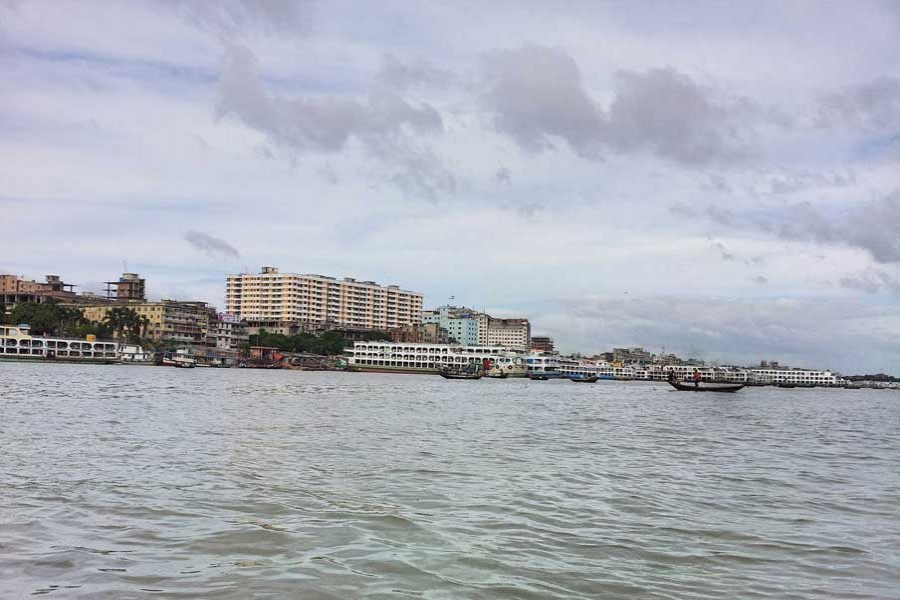The quality of Buriganga water has improved slightly following the relocation of tanneries to Savar from the capital's Hazaribagh area.
The improvement of water quality of this vital river is also attributable to this year’s heavy rainfall.
But experts think a lot more things, including checking other industrial and domestic wastes, need to be done to fully revive the water quality of this important river, reports UNB.
They also said the government should now take strong measures to shift the dyeing factories located at Shyampur on the bank of the river to another place as those have become a major threat to it after the ternary relocation with the discharging of high level of concentrated dyes, chemicals, and heavy metals directly into the Buriganga through the hidden pipelines.
Talking to UNB, water experts Prof Ainun Nishat and Buet Prof Md Mujibur Rahman and green activists Poribesh Bachao Andolon (Poba) chairman Abu Naser Khan and Bangladesh Paribesh Andolan (Bapa) general secretary MA Matin also said it is not possible to fully improve the water quality of the Buriganga without preventing pollution by other industries, Dhaka Wasa and city corporation.
The tests conducted by the Department of Environment (DoE) show that the water quality of the river improved as it found the level of average dissolve oxygen (DO) in its water was 2.3 mg/L at Sadarghat point in November compared to 0.00 mg/Lin January last year.
The DoE also found the level of BOD (biochemical oxygen demand) 2.6mg per litre during the same period against 11.5mg in January last year.
Contacted, Prof Ainun Nishat said it appears that the government has made some progress in reducing pollution in the Buriganga as the colour of its water has changed significantly. "It'll be clearly known whether the water quality has improved or not during the January-February period."
He said the tannery relocation, rainwater and the flow of freshwater from the Jamuna River into the Buriganga during the rainy season are the major reasons behind the improvement of water in the highly-polluted river.
The water expert said fishermen are getting some fish now in the Buriganga as its water has improved. "But, this is not enough. The government will have to plug the major sources of pollution of the river."
Prof Mujibur Rahman who has long been monitoring the Buriganga water pollution said, "Over 60,000 kgs of BOD is dumped into the Buriganga every day from industrial and domestic sources through the drainage system and there's no effective effort in sight to reduce it."
He also voiced concern that the Dhaleshwari River will be at stake if proper steps are not taken to check the untreated waste of the relocated tanneries in Savar. "Now the pollution by tanneries has been shifted to the Dhaleshwari from the Buriganga."
Abu Naser Khan said the water flow of the Buriganga River has increased as this rainy season has witnessed huge amount of rain, contributing to a slight improvement of its water quality.
The Poba chairman said there are two major challenges -- stopping both point and nonpoint sources of pollution and encroachment of the rivers -- to bring life back to the Buriganga and other rivers surrounding the capital.
He said most industries and factories do not have effluent treatment plants (ETPs) while those have do not operate them regularly for lack of the enforcement of law and monitoring.
MA Matin said nearly 100 tanneries are still in operation illegally in Hazaribagh area.
Besides, he said, dyeing factories in the city's Shyampur area has now become the main cause of pollution of the Buriganga after the relocation of nearly 250 tanneries from Hazaribagh.
Matin said the government should ensure either installation of effluent treatment plant at the dyeing factories or shift those from the bank of Buriganga to another place to protect the river.
The Bapa general secretary also said around 60 per cent pollution of Dhaka rivers caused by industrial waste while 30 per cent by Dhaka Wasa and two city corporations and 10 per cent by household wastes.
"Buriganga's water quality will improve further if only Wasa and the city corporation stop dumping their untreated wastes into the river," he added.


